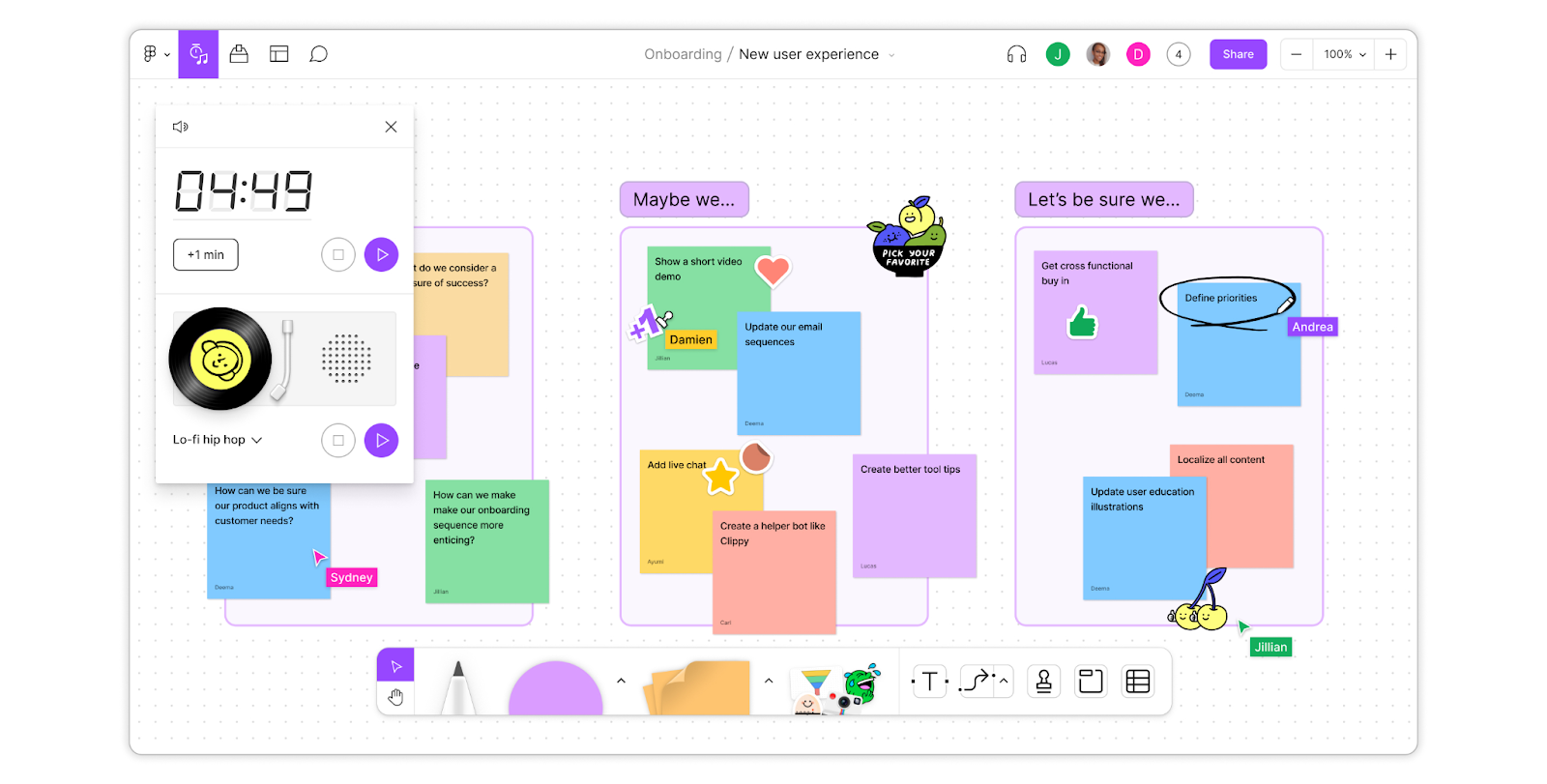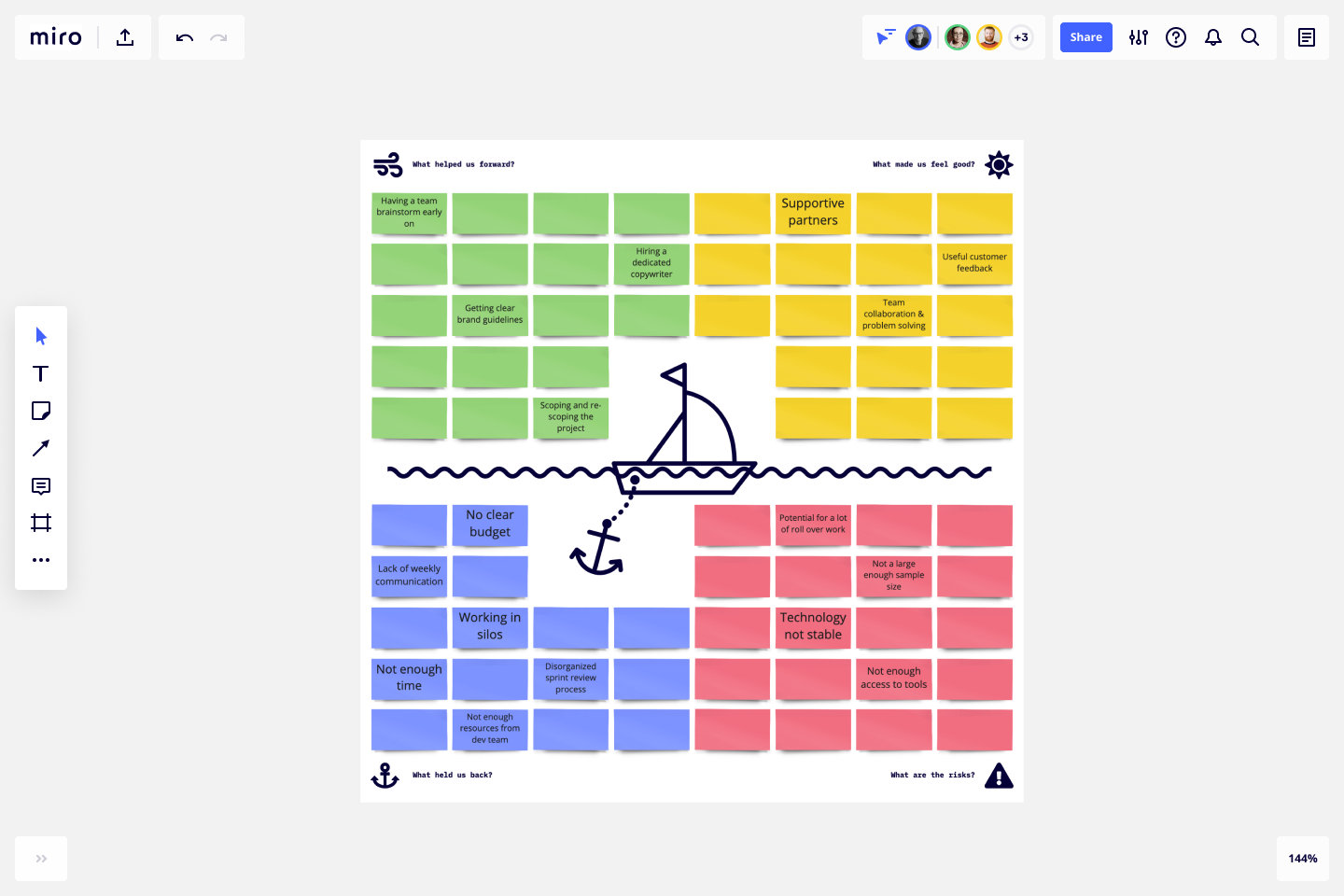Helpful summary
-
Overview: This article reviews ten of the best free retrospective tools on the market, including features, pricing, pros, and cons.
-
Why you can trust us: Teaminal is a leading Agile meeting tool that has helped thousands of teams worldwide improve their retrospectives.
-
Why this is important: A great tool can improve collaboration, transparency, and facilitation during retrospectives.
-
Action points: Our recommendations are Teaminal, Retrocat, RetroTool, Metro Retro, GoRetro, Parabol, Reetro, Scatterspoke, FigJam, and Miro.
-
Further research: Check out our list of the best Agile retrospective tools for more recommendations.
Agile teams consistently seek to enhance their processes and achieve better outcomes.
Retrospectives (and retrospective tools) play a big role in this process—they help you identify what’s working well, what can be improved, and how to make those improvements.
There are various retrospective tools available in the market today, each with their own pros and cons. As a team leader or facilitator, it’s important to know which tool would best fit your team’s needs.
At Teaminal, we understand the importance of choosing the right retrospective tool for your team. That’s why we have curated a list of top-rated tools that have been trusted by thousands of teams worldwide.
Let’s get started.
Why listen to us?
Teaminal has helped thousands of high-performing Agile teams at companies like Angi, Hello Fresh, and T-Mobile run quicker, more effective retrospectives. We have seen firsthand the positive impact that a great retrospective tool can have on team dynamics, communication, and overall project success.

But before we get to our list…
What is a retrospective tool?
A retrospective tool is any tool that Agile teams can use to facilitate their retrospectives.
Generally, retrospective tools help teams collect, organize, and visualize data from their sprints. They also often help facilitate feedback gathering, discussions, decision-making, and overall pulse-checking for the team.
Teaminal is a great example.

Our async Agile meeting tool is dedicated to streamlining retrospectives for distributed teams. It lets you easily write and send retrospective prompts, add action items, view completed work, and collaborate in real-time via Slack.
We also offer tools designed to optimize the other Agile rituals—but we’ll get into those later.
Why is using a retrospective tool important?
-
Reflection and learning: Retrospectives offer the best opportunities for structured learning out of any Agile ritual. Retro tools like Teaminal provide a space to reflect on past sprints and identify areas for improvement.
-
Increased transparency and collaboration: With a retrospective tool, the whole team can easily access and contribute to the discussion, instead of relying on one person to facilitate.
-
Organization and efficiency: Having all retrospective data in one place helps teams stay organized and focused, instead of wasting time trying to gather information from various sources. This also allows for more efficient decision-making and action planning.
-
Remote-friendly: In a world where remote work is becoming increasingly common, having a virtual retrospective tool is essential for distributed teams. It allows everyone to participate regardless of location, time zones, or work style differences—meaning everyone’s voice can be heard and valued.
-
Data-driven insights: With a retrospective tool, teams have access to data and analytics that can provide valuable insights into their processes and identify areas for improvement. This allows for more informed decisions and continuous improvement.
What to look for in a retrospective tool?
-
Ease of use: Your team’s willingness to adopt and engage with a tool is largely dependent on how much of a hassle it is to use. Ideally, the tool you choose should make life easier by simplifying the process of setting up, conducting, and analyzing retrospectives.
-
Customization options: Every team is unique and has its own way of working. As such, it’s important to pick a retrospective tool that allows for customization so that you can tailor it to your specific needs.
-
Collaboration: A retrospective tool should provide a platform that allows team members to easily work together and share their thoughts and ideas. This promotes a sense of unity and encourages productive discussions.
-
Integration: Finally, the tool you pick should integrate with others in your stack to pull in data on complete work, bugs, and other metrics. This will provide a more comprehensive view of your team’s performance and help identify areas for improvement.
10 best free retrospective tools
-
Teaminal: Best all-in-one async Agile meeting tool.
-
Retrocat: Best for real-time collaboration.
-
RetroTool: Best for helping teams reflect anonymously.
-
Metro Retro: Best for beginners in running a retrospective meeting.
-
GoRetro: Best for online sprint management.
-
Parabol: Best for scrum masters and other leaders conducting guided retrospectives.
-
Reetro: Best for planning, executing, and managing retrospective.
-
Scatterspoke: Best for generating metrics-driven insight.
-
FigJam: Best for brainstorming, collaborating, and visualizing ideas in real time.
-
Miro: Best for collaborative diagramming.
1. Teaminal
Teaminal is an all-in-one Agile meeting tool with a great set of features for improving retrospectives.
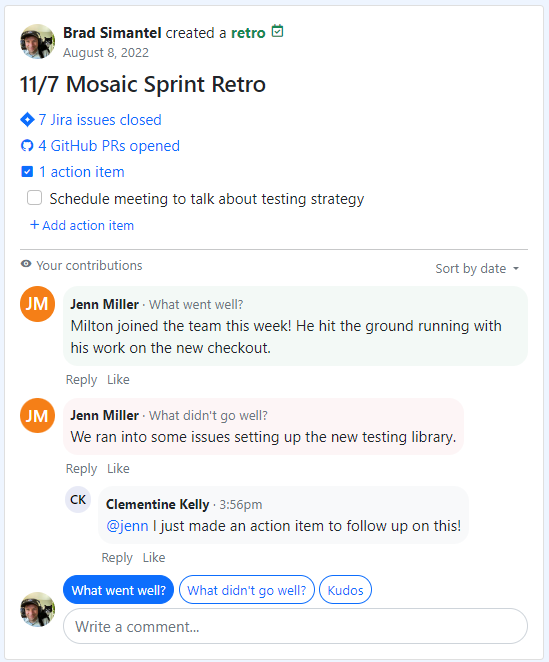
For starters, all of Teaminal’s features (including retrospectives) are fully accessible through Slack to give your team one, central place to view and act on your retrospective tasks. When you run a retrospective, Slack will notify the invited team members and ask them to respond to the prompts you’ve set.
Teaminal enriches each retro with data pulled in from integrated tools like GitHub and Jira, as well as daily standups logged with Teaminal throughout the sprint.
Key Features
-
Slack-Based: Run retrospectives through Slack (or Teaminal’s web app) to minimize switching between tools and streamline communication.
-
Async Retrospectives: Run fully asynchronous retrospectives to cut down on lengthy, unnecessary meetings.
-
Customizable Prompts: Use Teaminal’s default retro prompts, or write your own for more targeted insights.
-
Deep Integrations: Pull in data from your integrated tools to give context and visibility into team performance.
-
Actionable Insights: Analyze retro data through reports to identify trends and take action on issues that keep coming up.
-
All-In-One Agile Meeting Platform: Access async tools for all Agile rituals—daily standups, planning poker, backlog grooming, reports, and more.
Pricing
Teaminal’s price ranges from free to $12/user/month.
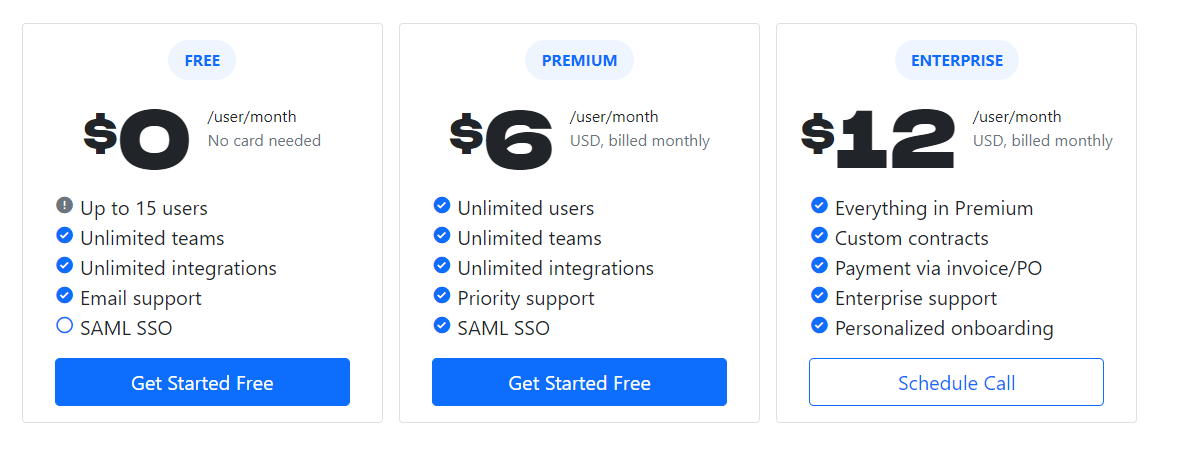
The free plan gives 15 users full access to the platform. Premium ($6/user/month) and Enterprise ($12/user/month) both support unlimited users, with Enterprise improving on Premium with extras like personalized onboarding and custom contracts.
Pros and Cons
Pros
-
Offers budget-friendly pricing options compared to other tools
-
Boasts an intuitive and easy-to-navigate user interface
-
Provides a diverse range of features to meet different team needs
-
Can be customized to suit the specific requirements of any team
-
Provides outstanding customer support
Cons
- Email support only on the free plan
2. Retrocat
Retrocat offers a user-friendly interface, customizable templates, and real-time collaboration features. It provides a limited (but well-designed) set of features that promote discussions, keep your team on track during retrospective sessions, and help you zero in on insights.
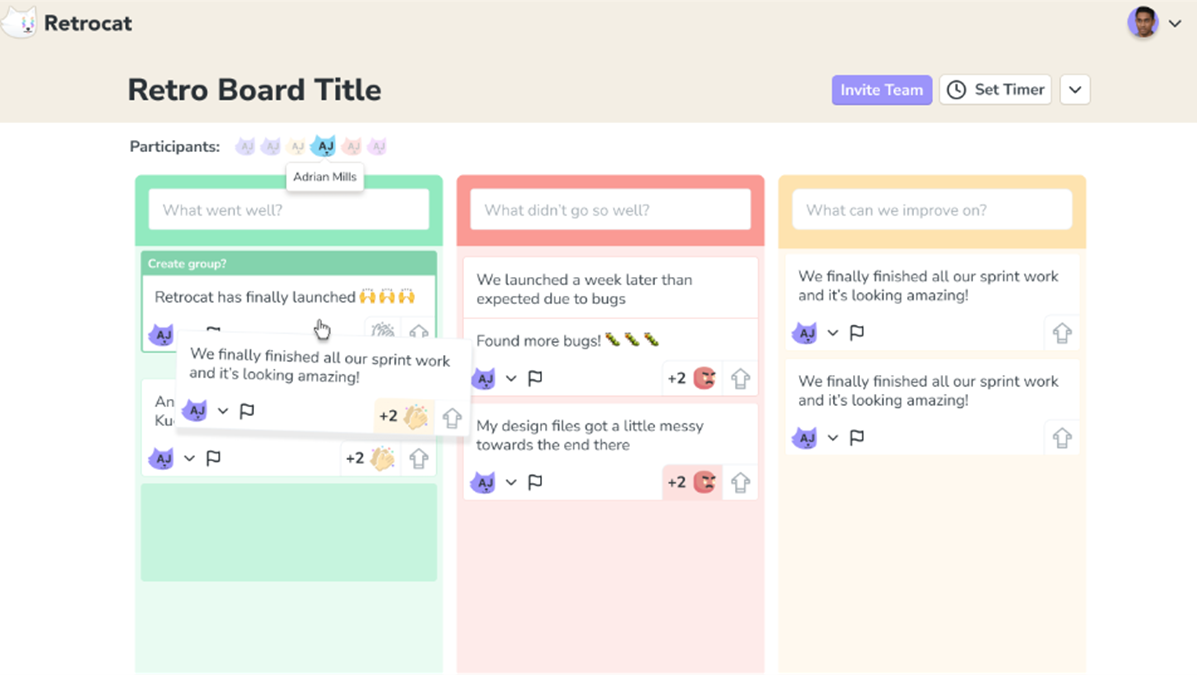
Key Features
-
Easy Setup: Create a retrospective board, invite your team, and start collecting feedback in minutes.
-
Session Timer: Set a timer for your retrospective session to keep everyone on track and focused.
-
Reactions: Add reactions to tickets, comments, and ideas to express your feelings and opinions.
-
Customizable: Choose from a variety of templates or create your own to fit your team’s unique needs.
Pros and Cons
Pros
-
Intuitive user interface
-
Customizable templates
-
Real-time collaboration capabilities
Cons
-
Limited functionality in comparison to alternatives
-
Absence of a mobile application
-
Lack of integration with other tools
-
Inability to attach files to retrospectives
3. RetroTool
RetroTool is an intuitive tool designed to effortlessly facilitate engaging retrospectives, ideal for remote or hybrid teams.
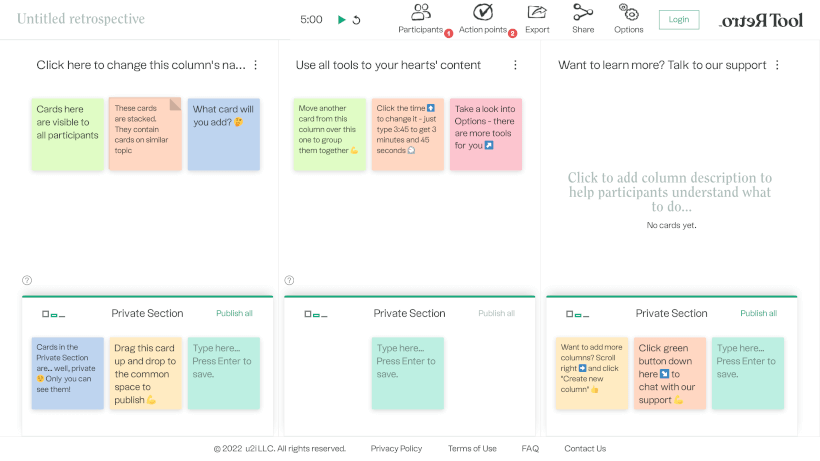
With customizable templates, real-time collaboration, automated reminders, analytics, and reporting features, RetroTool streamlines and automates the entire retrospective process, from start to finish.
Key Features
-
Intuitive UI: Drag and drop “sticky notes” and images onto a whiteboard to capture ideas, feedback, and action items.
-
Customizable Templates: Choose from various templates like the “Starfish” or “Glad, Sad, Mad” to structure your retrospectives.
-
Action Points: Collect action items and assign owners to keep track of progress.
-
Anonymity Options: Decide whether you want feedback to be anonymous or whether you want to require names.
Pricing
RetroTool’s free plan supports all core features and lets you run unlimited retrospectives.
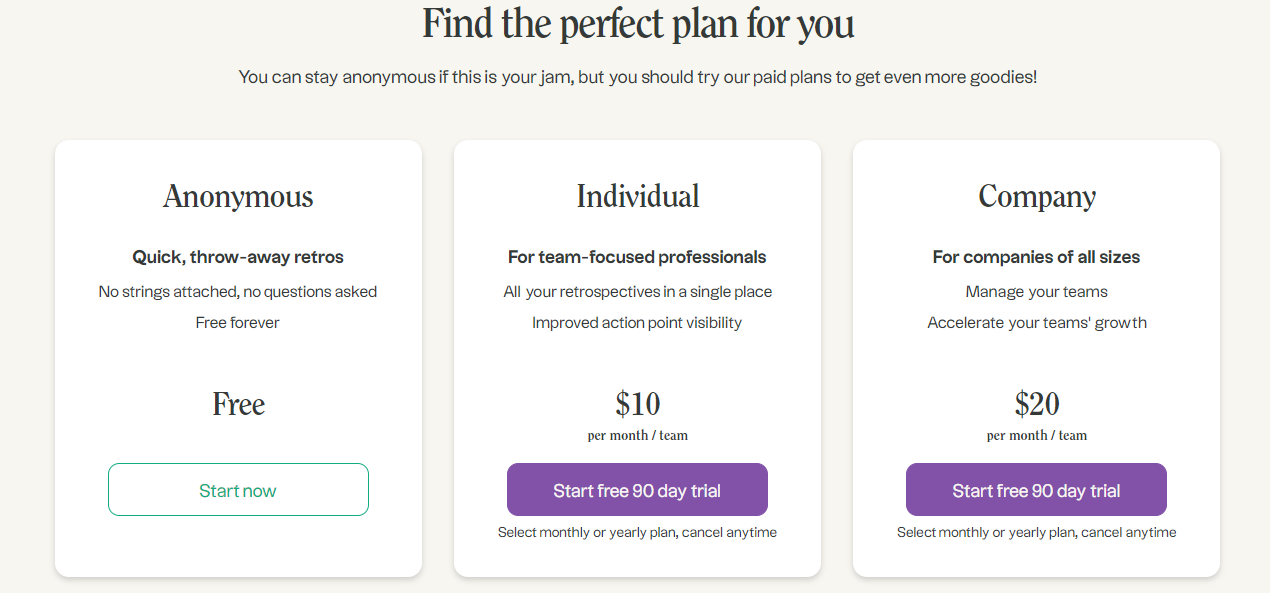
Individual ($10/team/month) and Company ($20/team/month) support advanced features like enhanced customization and access controls.
Pros and Cons
Pros
-
User-friendly interface
-
No signup necessary
-
Great free tier
-
Tracks historical retro data
Cons
-
Fairly limited features
-
Important features are paywalled
4. Metro Retro
Metro Retro is an online whiteboard tool designed to make retrospectives fun, creative, and impactful through live collaboration. Its features include tons of customizable templates, facilitator controls, polls, and more.
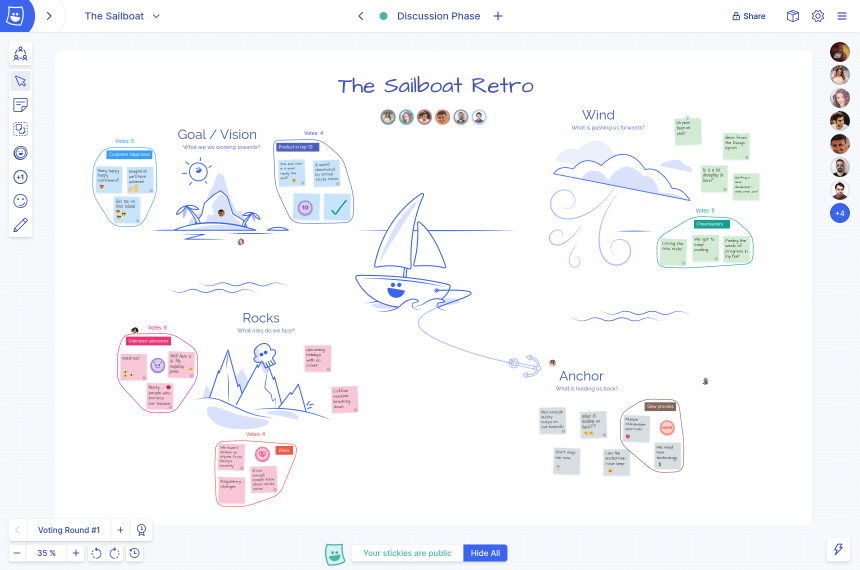
Key Features
-
Boards & Templates: Build custom whiteboard templates or choose from a variety of pre-made templates for retros, planning sessions, and more.
-
Facilitator Controls: Assign roles to team members, lock the board during discussions, and control access levels for enhanced customization.
-
Live Collaboration: Team members can contribute in real-time from anywhere in the world with no registration necessary.
-
Anonymity: Metro Retro allows team members to anonymously contribute, providing a safe space for open and honest feedback.
Pricing
Metro Retro offers three plans—Free, Pro, and Business.
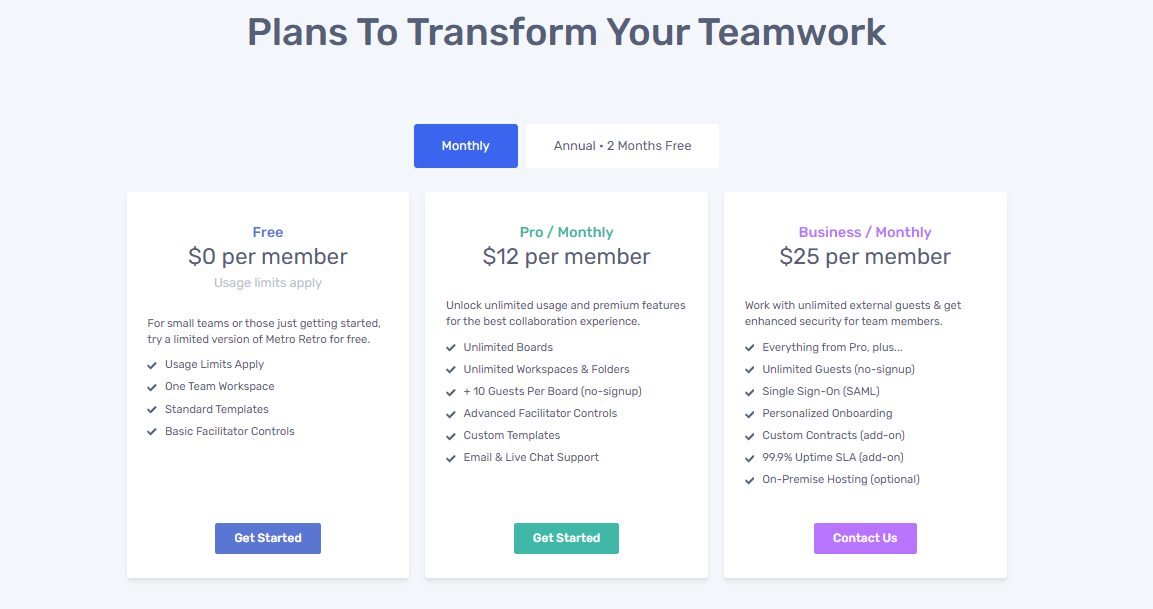
The free plan is suitable for small teams or those just starting out, with limited features and usage caps. Pro ($12/user/month) offers unlimited boards, workspaces, and additional premium features.
Business ($25/user/month) offers enhanced security, unlimited external guests, and additional benefits like personalized onboarding and on-premise hosting.
Pros and Cons
Pros
-
Intuitive user-friendly interface
-
Adaptable and customizable templates
-
Real-time collaboration capabilities
Cons
-
No custom templates on free plan
-
Difficult to standardize retro data
5. GoRetro
GoRetro is a versatile project management software designed to streamline project workflows and enhance collaboration among team members. It offers a range of tools and features for effective planning, execution, and tracking of projects.
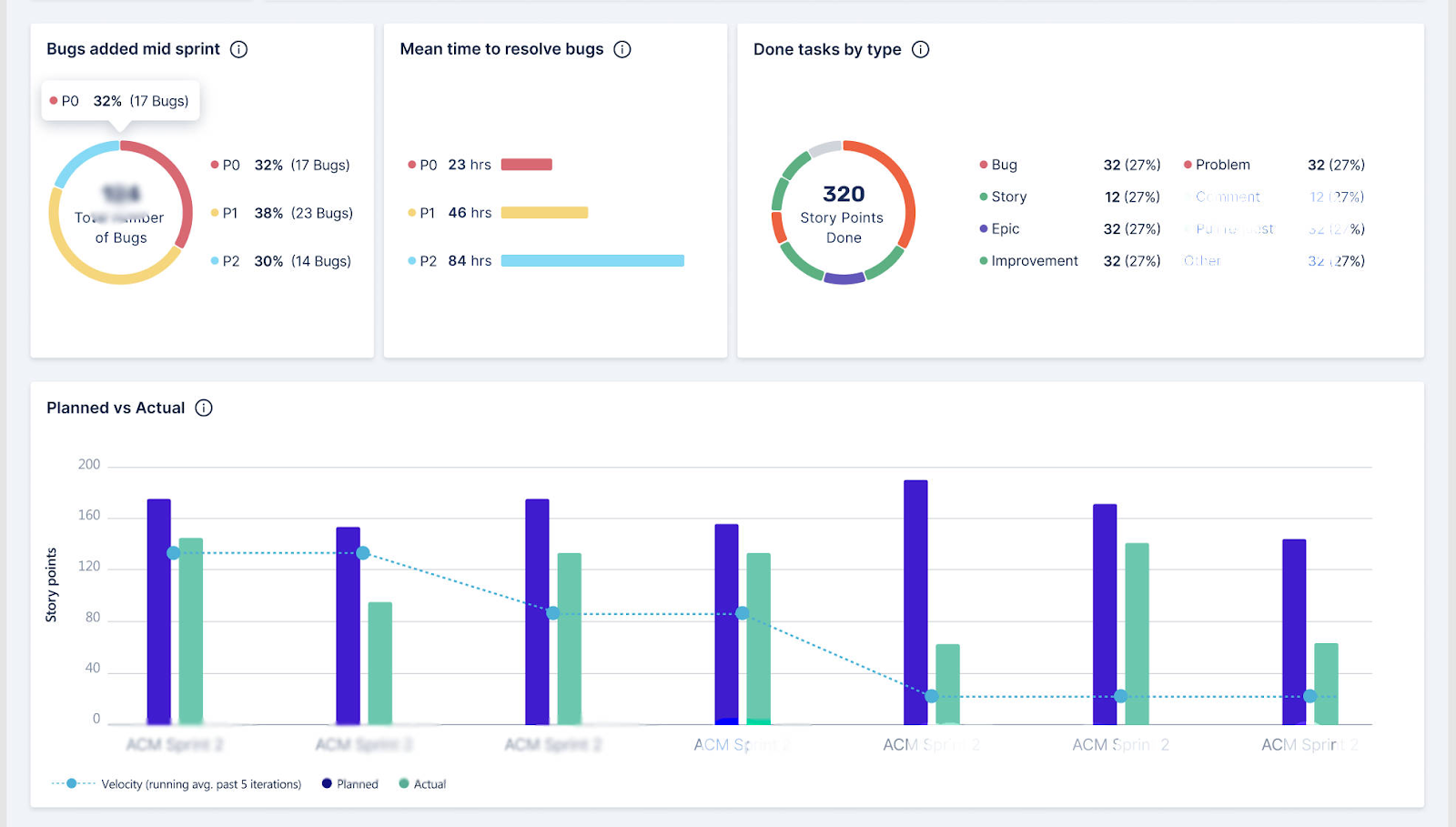
This platform excels at facilitating engaging sprint retrospective conversations, making it suitable for startups, freelancers, small to large businesses, non-profits, and personal use alike.
Key Features
-
Task Management: Allows creation and assignment of tasks, setting due dates, and tracking task completion.
-
Team Collaboration: Centralized platform for communication, file sharing, and collaboration on project-related discussions.
-
Progress Tracking: Features for project visualization, including Gantt charts and Kanban boards.
-
Reporting and Analytics: Custom reports on project progress, team performance, and resource allocation.
Pricing
GoRetro offers different pricing plans to cater to the needs of various teams.
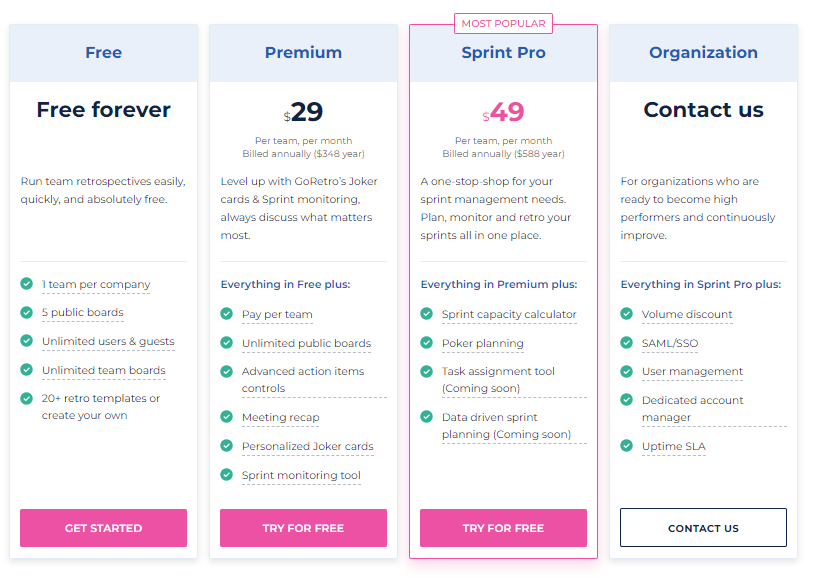
The pricing ranges from free forever with limited features to a range of premium plans—Premium ($29/team/month), Sprint Pro ($49/team/month), and Organization (custom). The premium plans provide additional features like advanced action item controls, personalized Joker cards, and sprint monitoring tools.
Pros and Cons
Pros
-
Streamlined approach to handling retrospectives and sprints
-
Boost team participation during meetings
-
User-friendly interface
Cons
-
Limited customization in some areas
-
Occasional bugs
6. Parabol
Parabol is an online meeting tool specifically designed to support Agile methodologies. It caters to various meeting types, including retrospectives, sprint poker estimation, standups, and team check-ins. Parabol is great for remote, hybrid, or distributed teams, providing digital boards, cards, and templates for streamlined and time-efficient meetings.
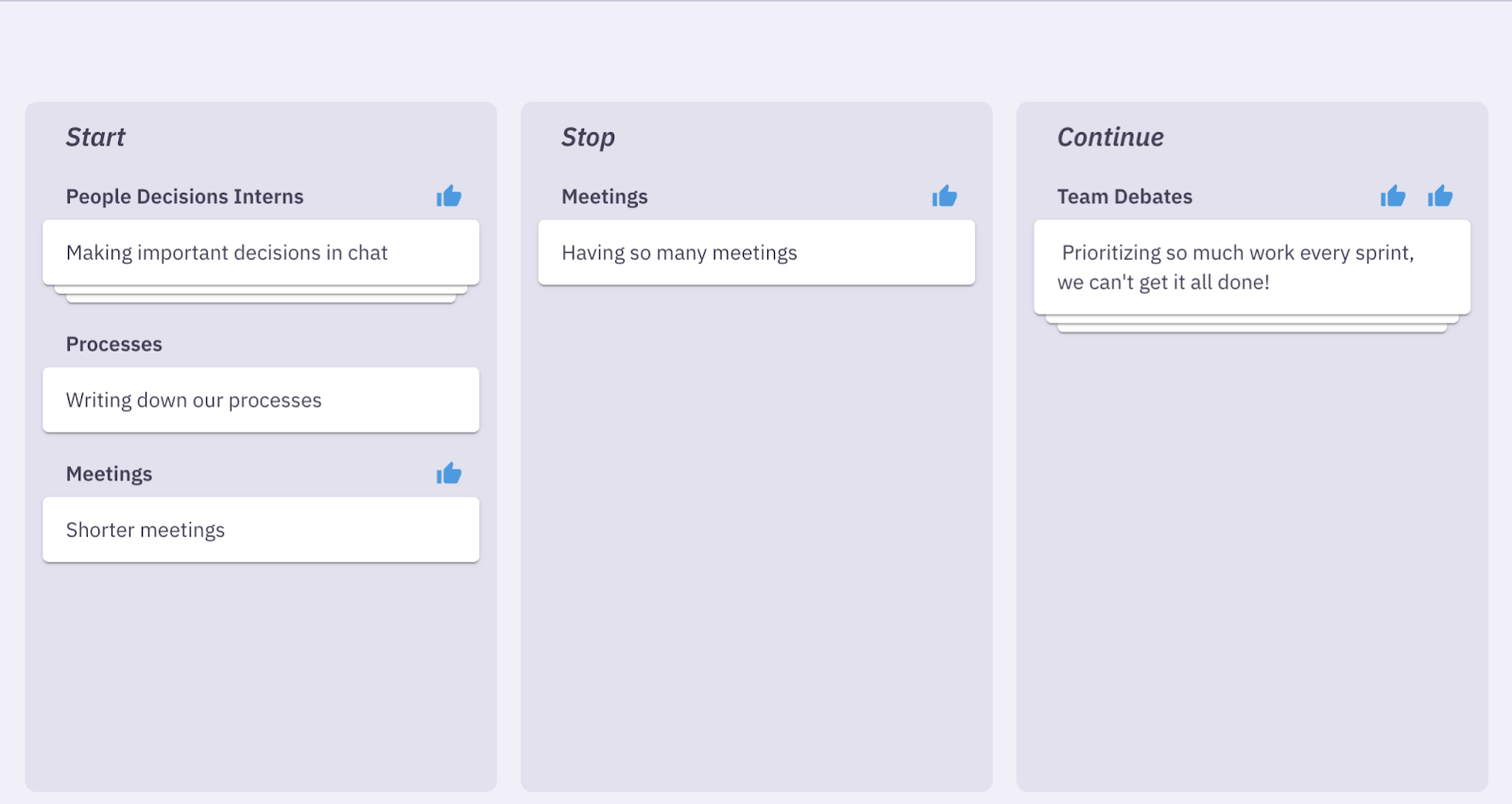
Notable for its anonymous input, discussion threads, and automated meeting summaries, Parabol integrates with popular tools like Jira, GitHub, and Slack.
Key Features
-
Agile Meeting Facilitation: Helps Agile teams facilitate various meeting types, from daily standups to backlog refinement and retrospectives.
-
Remote Collaboration: Enables remote teams to collaborate effectively through digital boards, cards, and templates.
-
Integration with Popular Tools: Integrates with popular tools like Jira, GitHub, and Slack for a seamless workflow.
-
Automated Summaries: Generates automated meeting summaries, saving time and keeping everyone on the same page.
-
Anonymous Input: Allows for anonymous input, allowing team members to share their thoughts without fear or bias.
Pricing
Parabol offers three plans—Starter, Team, and Enterprise.
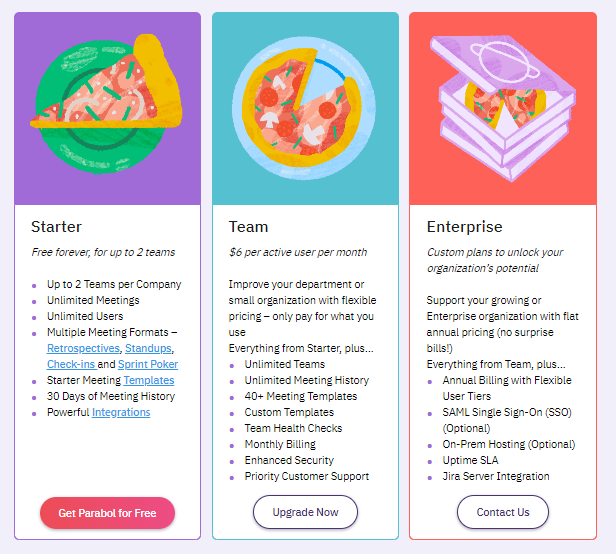
The Starter plan is free forever and allows for up to 2 teams. Team ($6/user/month) includes unlimited teams and meeting history, along with additional features like custom templates and enhanced security.
The Enterprise plan offers custom pricing for larger organizations and includes all the features of the Team plan, as well as options like SAML Single Sign-On and Jira Server Integration.
Pros and Cons
Pros
-
Seamless virtual retrospectives
-
Ease of scheduling and managing meetings
-
Intuitive and well-designed user interface
Cons
-
Limited templates
-
Lacks advanced scheduling features.
7. Reetro
Reetro is a versatile and user-friendly retrospective tool designed specifically for Agile teams. It facilitates collaboration, enabling teams to enhance and evolve their processes.
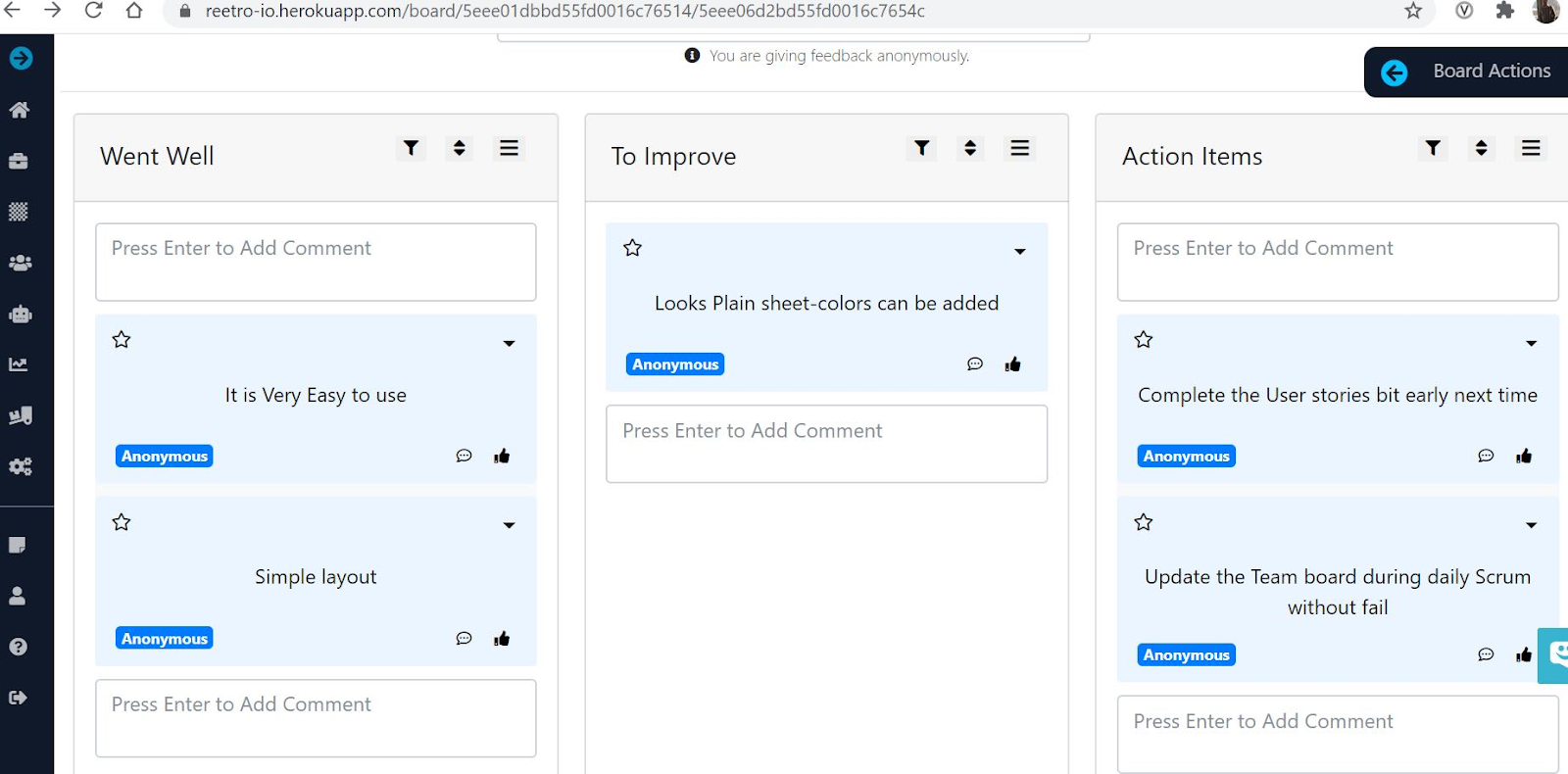
Standout benefits include its simplicity, intuitive interface, and the fact that it’s a free tool offering a range of useful features for effective retrospectives.
Key Features
-
Retrospective Automation: Automates board creation and feedback collection, ensuring everything is ready for retrospective meetings.
-
Analytics: Offers analytics to review past retrospectives, providing insights for process improvement.
-
User Interface: Enjoy a simple, visual and easy-to-use interface that facilitates collaboration within teams.
-
Customizable Boards: Create customizable boards with different templates to fit your team’s needs.
Pricing
Reetro offers three pricing plans—Free, Pro, and Enterprise. The free plan is forever free and includes features like unlimited teams, boards, and users, as well as exports to various platforms.
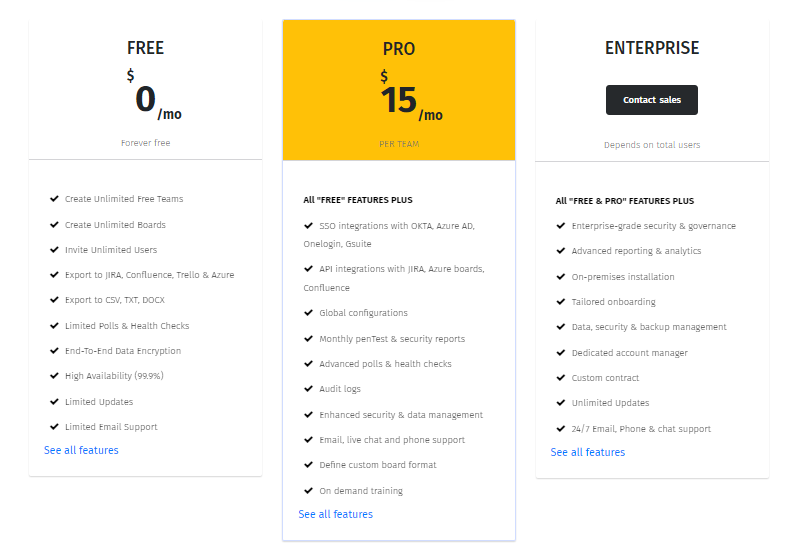
Pro ($15/team/month) provides additional features like SSO integrations, advanced polls and health checks, enhanced security, and email, live chat, and phone support. Enterprise (custom) offers enterprise-grade security, advanced reporting and analytics, on-premises installation, a dedicated account manager, and 24/7 email, phone, and chat support.
Pros and Cons
Pros
-
Ease of automation and setup
-
Provides insights into the retrospective process
-
Supports extras like audit logs and on-premise installation
Cons
- Limited reviews
8. Scatterspoke
ScatterSpoke is a retrospective tool designed to help teams conduct data-driven retrospectives for continuous improvement. The tool focuses on enabling teams to make process improvements based on data to keep morale high.
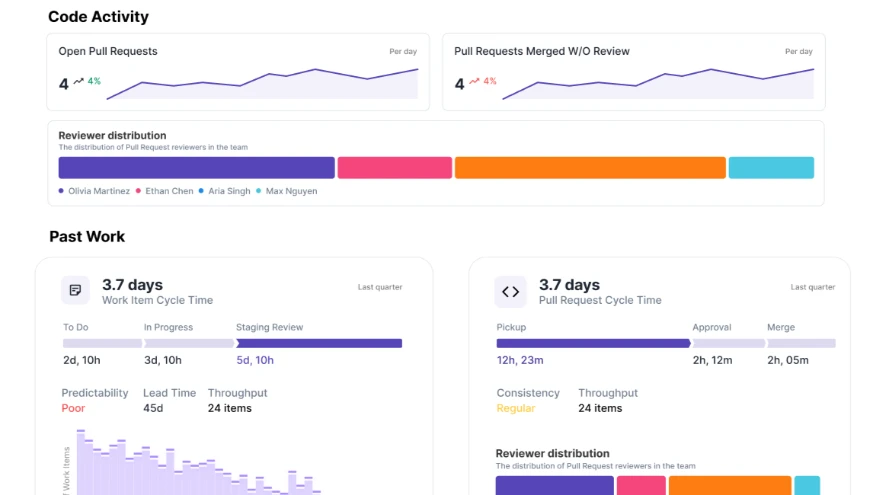
ScatterSpoke provides a platform for customizing retro formats, posting cards in real-time, voting on issues, and gathering metrics on common patterns to make targeted improvements.
Key Features
-
Data-Driven Retrospectives: Offers analytics that connect data and visualize trends about team health.
-
Customizable Formats: Allows customization of retro formats, including color-coded cards and anonymous cards for unbiased feedback.
-
Facilitator Controls: Includes facilitator role for managing retrospectives and controlling visibility of votes and cards.
-
Integrations: Fully integrates with Slack, Trello, and Jira for seamless communication and action item management.
-
Exporting Options: Provides options to export retrospectives as PDF, Excel files, or share via email.
Pricing
ScatterSpoke offers three pricing plans—Starter, Business, and Enterprise.
The Starter plan is free and suitable for organizations just getting started, supporting up to 50 members.
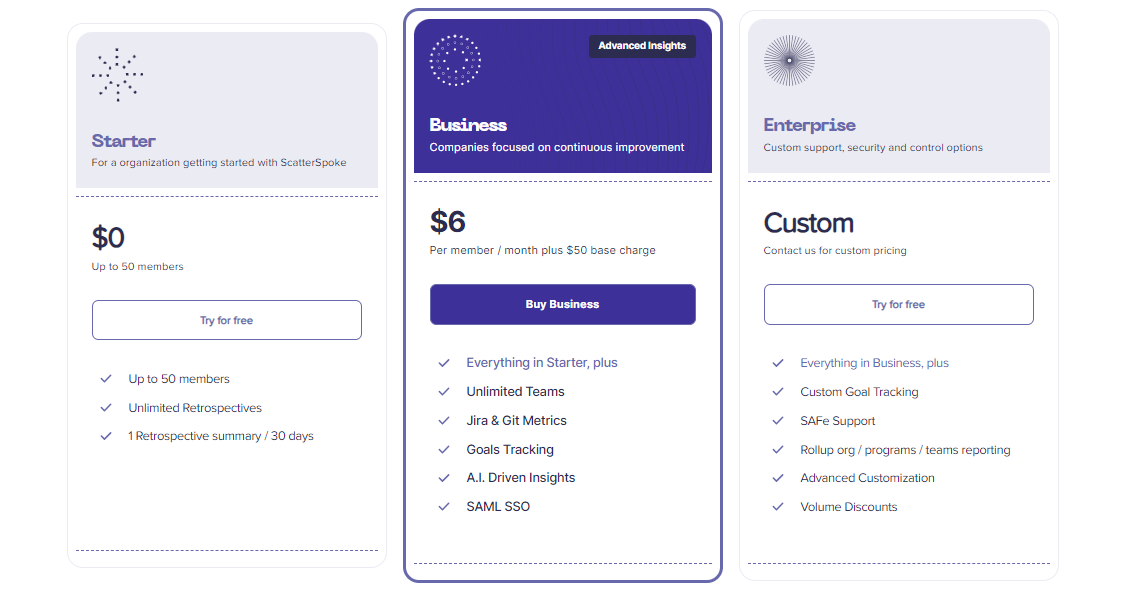
Business ($6/user/month + $50 fee) provides advanced features like unlimited teams, Jira & Git metrics, and AI-driven insights. The Enterprise plan offers custom support, security, and control options, with pricing available upon request.
Pros and Cons
Pros
-
Simple and easy to navigate
-
Focus on data to drive retrospectives
-
Versatile formats
-
Great data visualizations
Cons
-
Lacks reviews
-
Only one retro summary per month on the free plan
9. FigJam
FigJam is a collaborative whiteboarding tool designed to complement Figma’s flagship product. It’s mainly designed for brainstorming sessions, but works well as a retrospective tool thanks to its intuitive visual interface, range of templates, and built in timer.
Key Features
-
Real-Time Collaboration: Multiple users can work simultaneously on a digital canvas.
-
Templates: A wide variety of templates for different use cases.
-
Design Libraries: Access to Figma’s design libraries for consistent and on-brand artifacts.
-
Timer: Built-in timer to keep meetings on track and efficient.
Pricing
Figma offers a range of pricing plans to suit different needs.

The Starter plan is free, while Professional ($12/user/month) and Organization ($45/user/month) will cost you. There’s also an Enterprise plan ($75/user/month) for large teams that need advanced security and compliance.
Pros and Cons
Pros
-
Real-time collaboration capabilities
-
Easy to use for sketching and discussing wireframes
Cons
-
Limited diagram presets
-
Navigating through projects can be confusing
10. Miro
Miro is a popular visual collaboration platform known for its extensive features. As a retrospective tool, it allows teams to gather feedback and ideas in real-time. With its digital whiteboard, users can brainstorm, organize ideas, and create diagrams for visual presentations.
There are also retrospective templates available to help guide teams through the process.
Key Features
-
Collaborative Platform: Stands as a collaborative whiteboard platform designed for real-time teamwork.
-
Templates: Provides a diverse array of templates tailored for retrospectives, streamlining the initiation process and enabling customization to align with your team’s specific requirements.
-
Interactive Features: Incorporates interactive elements like icebreakers, reactions, and voting, enhancing the engagement and enjoyment of retrospectives.
-
Agile Integration: Seamlessly integrates with Agile project management tools like Jira, Azure, and Asana, allowing easy transformation of retrospective feedback into actionable tasks.
-
Topic Clustering: Miro’s topic clustering feature enables the grouping of stickies based on color, tag, author, keyword, and sentiment.
Pricing
Miro offers a range of pricing plans to cater to different needs.
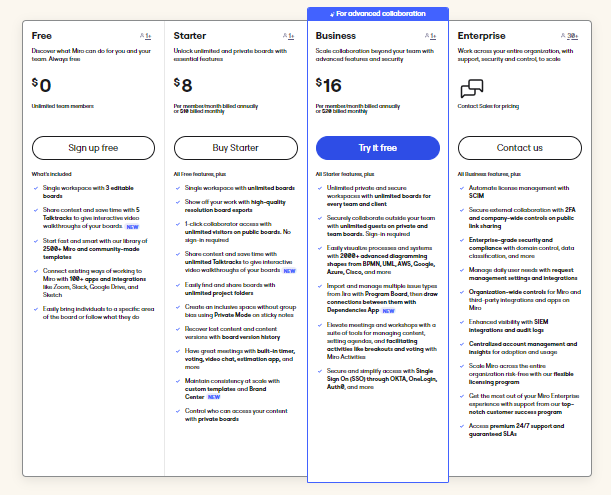
The pricing starts with a free plan that provides basic features and limited boards. The paid plans include Starter ($8/user/month), Business ($16/user/month), and Enterprise (custom).
Pros and Cons
Pros
-
Versatile collaboration tools
-
User-friendly interface
-
Seamless integration with various digital tools
Cons
-
Has a learning curve
-
Limited integrations
Conclusion
When it comes to retrospective tools, there are plenty of effective and free options available for teams. These tools offer a range of features like asynchronous feedback collection, integration with project management tools, configurable templates, and automatic data enrichment.
At Teaminal, we offer Agile teams a suite of tools designed to optimize their workflow—from backlog grooming to retrospectives. We believe async is the way to go when it comes to retrospectives, and our tool allows teams to collect feedback anytime, anywhere.
Sign up for free today and win back hours of development time from unnecessary face-to-face meetings.

